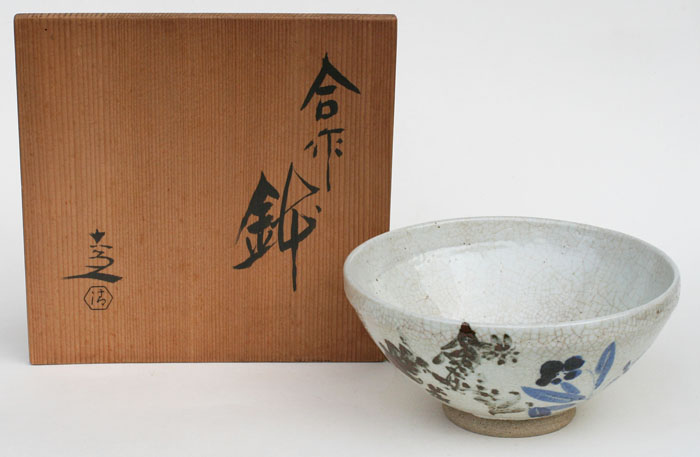Kyôyaki
Kashibachi, cake bowl – Meeting of spring - and autumn flowersSigned: Kahô, Shunpô, Kôun
Seals: Kiyo
Technique: Grey crackled kyôyaki, with iron oxide, tetsu-e, underglaze paintings in blue, brown and black Ø 19,9 x 9,3
Box: signed by Rokubei and Kahô
A Gassaku is a collaborative work that can take many forms. It can be a single hanging scroll painting, a hand scroll, an album or even a screen executed by two or more artists, and like most pottery in this catalogue, ceramic works too.
Social events like New Year parties, or parties organized by patrons, as well as the cultural literary gatherings, memorial services and exhibitions all provided good opportunities for artists to affirm shared ideals and to exchange paintings and calligraphy
At the end of a party, a gathering, an exhibition or any other appropriate occasion, the artists present might decide to produce a work together. The result should be an artistic ’epilogue’ to the gathering, which would be left as a memento of the event.
Kahô, Shunpô and Kôun were all pupils of Kikuchi Hôbun (1862-1918).
Kahô was born in Kyoto. He studied with Kôno Bairei (1844-1895) first and later became a student of Hôbun. He was a frequent exhibiter at the Bunten shows.
Reference:
Roberts p. 72
Aburai p. 129
Shunpô was one of Hôbun’s best pupils. His first appearence was at the Bunten in 1907, his last at the Teiten in 1944. His style, based on that of his teacher, became a modern interpretation of the Rimpa-style.
Reference:
Berry '01 p.195
Aburai p. 15
Kôun, a pupil of Kikuchi Hôbun (1862-1918) was born in Kyoto. He exhibited in 1918 at the Bunten and in 1926 at the Teiten. From 1915 through 1918 Kôun and his teacher Hôbun were in The Hague in the Netherlands to work on the Japanese room at the Peace Palace.
Reference:
Roberts p. 195
Aburai p. 406
Araki p. 1558
Rokubei V, the second son of Kiyomizu Rokubei IV, studied Shijô painting with Kôno Barei (1844-1895) and also at the Kyoto Prefectural School of Painting. After his graduation he studied ceramic techniques with his father and glazing techniques at the Kyoto Municipal Ceramic Laboratory. He worked on the research of new glazing techniques and western designs. When Rokubei IV retired in 1913, he inherited the title and became Rokubei V. He exhibited at the Nôten, the Design and Applied Artworks Exhibition sponsored by the Ministry of Agriculture and Commerce, and at the Teiten, the Imperial Art Academy Exhibition. He also became a member of the Imperial Art Academy and played an important role as a leading figure of the craft world. In 1945 he retired.
Reference:
Kyoto ‘03, ’Sekka’ p. 326 ff.
Price: ON REQUEST

